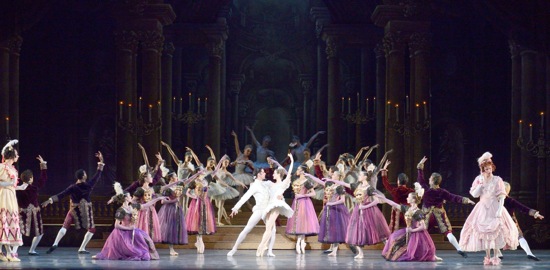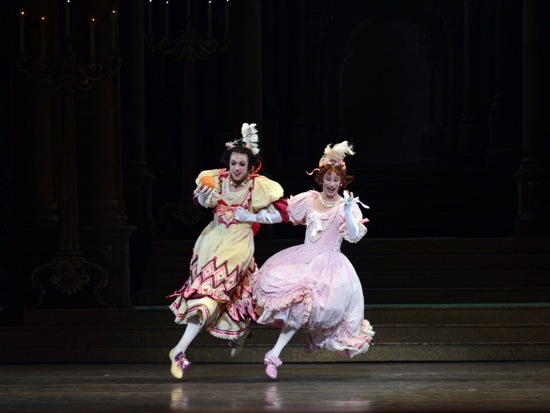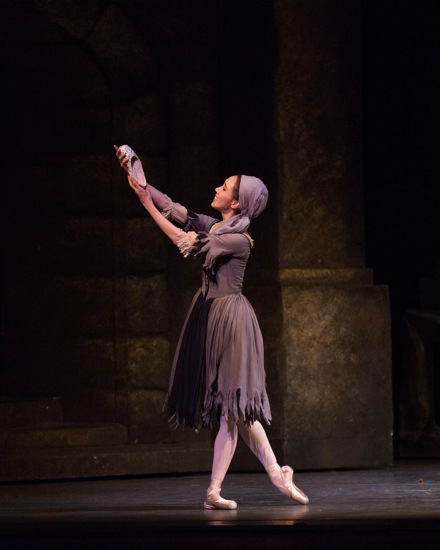American Ballet Theatre mounts Frederick Ashton’s Cinderella during its spring season.

Cinderella (Julie Kent) and her Prince (Marcelo Gomes) in American Ballet Theatre’s production of Frederick Ashton’s Cinderella. Roman Zhurbin (L) and Craig Salstein as the stepsisters. Photo: Gene Schiavone
It’s rare that a dance review starts out with praise for a company’s artistic director, but I need to congratulate Kevin McKenzie. In the last two decades, “his” company, American Ballet Theatre, has commissioned two new ballets based on the tale of Cinderella. (McKenzie himself danced in Mikhail Baryshnikov’s 1983 version for ABT.) So I—and numerous others—are delighted that he chose not to revive Ben Stevenson’s Cinderella that entered the repertory in 1996 or James Kudelka’s 2006 production. Neither did he commission a trendy new one.
Instead for its 2014 spring season at the Metropolitan Opera (May 12 through June 30), the company has mounted the lovely and witty Cinderella that Frederick Ashton made in 1948 for England’s Royal Ballet (then the Sadlers Wells). It’s the fairest of them all.
The story, whether told by the Brothers Grimm or Charles Perrault, is a fairly straightforward one. I need not expound on the trials and triumph of the beloved daughter, who became the prey of a stepmother her widowed father ought never to have married. This woman’s two offspring could have given today’s schoolgirls new insights into bullying: keep the victim in rags and then make fun of her clothes, assign her all the housekeeping chores, let her sleep on the hearth. Enter the Fairy Godmother. The Ball. The Prince. The Happily Ever After.
What’s so wonderful about Ashton’s ballet in addition to Sergei Prokofiev’s splendid score (created for the Bolshoi Ballet’s 1945 production) is the way that the choreography links expressive, imaginative choreography with astutely designed dramatic action at the same time that it streamlines the narrative. There is no stepmother, and no entertainers perform at the ball—unless you count the agile Jester, who does most of the firework dancing. In fact (and I find this a lacuna), the stepsisters appear to be the only contenders for the Prince’s hand—at least until Cinderella arrives. All the other invited women wear identical dresses (set and costume design by David Walker) and have come with escorts.
This Cinderella also eliminates the long search for the owner of the dropped glass slipper. The two stepsisters have just come home from the ball in the early morning hours and started to take off their dresses, when the Prince appears with his retinue. He wants that beautiful girl, and he’s not wasting a second finding her. The sisters don’t even have time to re-fasten the buttons on their clothes before trying to stuff their feet into the little shoe.
Ashton originally intended Cinderella’s stepsisters to be played by women, but various circumstances conspired against this, and Robert Helpmann and Ashton created the roles at Cinderella‘s Sadlers Wells debut. Their personal characterizations added to the inevitable effects of men playing women. The motherless stepsisters became not simply nasty and demanding, but awkward and unattractive—the Helpmann sister being the assertive one, and the Ashton one shy and easily led. How rudely they squabble over a shawl until they tear it in two! How comically they botch the Dancing Master’s attempts to teach them a gavotte! But there are poignant aspects to the Ashton sister’s role; she forgets her solo at the ball and has to ask her sister to remind her of the steps. Even their byplay (if you notice it) is detailed. The shy sister, standing on the sidelines with a partner, surreptitiously feels his biceps and smiles a little smile.

Thomas Forster (L) and Kenneth Easter as the stepsisters in Ashton’s Cinderella. Photo: Gene Schiavone
Wendy Ellis Somes, who danced in the ballet in England, and Malin Thoors staged the ABT production with attention to such aspects of the story. In the ABT cast that I saw, Kenneth Easter and Thomas Forster played the stepsisters to fine comedic effect and with some subtlety. The differences between them were accentuated by the fact that Forster is considerably taller than Easter—taller, too, than Grant DeLong, as Cinderella’s weak-willed father. They are wonderfully matched, though, in the way that they hang onto each other and leap across the stage holding out in front of them the oranges (one huge, one small) that the Prince intended to give Cinderella. Their greed drives them the way the carrot lures the donkey.
The Cinderella I saw was Xiomara Reyes. She was lovely—fresh, gentle, easily made happy—and she danced with silky ease. Ashton’s clever idea of having her pretend the broom is the Prince that she expects never to see is a marvelous one, and Reyes shows us how our heroine can find pleasure in small things, occasionally gazing toward the usually hidden portrait of her mother, as if asking for approval of the wood and straw suitor.
Watching Reyes, I become enchanted all over again by Ashton’s love of pointework. Cinderella doesn’t just step-and-perch on those toe shoes; little shivery steps and the intricate ways that her feet cross and uncross mingle with bigger, swoony moves to reveal her excitement. This heroine spends more time on tiptoe than most ballerinas do. When she enters the ballroom, she walks down a wide flight of steps on pointe, never once gazing down. Reyes does this beautifully, hinting at the poetic and transformative power of love that mattered so much to Prokofiev. Even before she lays eyes on the Prince (the excellent Joseph Gorak), when Reyes comes down those steps and walks toward the audience, her awe grows into confident delight. It’s like watching a bud open into full flowerhood.
Also notable in Ashton’s choreography is his use of épaulement. When Cinderella twists her body slightly and gazes over her shoulder, or above an appositely raised arm, the space around her body become more diverting, more alive. You see this too in the dancing of her Fairy Godmother (Devon Teuscher) and the others.
The choreographer also provided splendid patterns for the ensemble, especially for the dozen women in white who are identified as Stars. They interweave, circle, form arches to be passed through and clusters that unfold. At the climax of the ballroom scene, the courtiers dance in a circle around the embraced lovers, conveying both a dizzily turning wheel of fortune and the clock that is about to strike midnight. Although Cinderella’s leap-and-spin circle of the stage in the ballroom pas de deux is a traditional solo closer, it too seems to suggest the clock that rules her destiny.
The party-goers, who have previously impressed us with their ensemble work emerge briefly as individuals as they head home in front of a downstage curtain. We see little vignettes. These two are in love. These women have had it with that man. Ashton liked dancers to look like people who just happened to have skills others can only imagine.
The ABT cast I saw performed the many fine passages of dancing beautifully. As I remember, it was Patrick Frenette as the Jeweler who burst into a flare of leaps at the be-decking of the sisters. The agile Arron Scott, as the Jester, has all manner of virtuosic steps to show, and he winks conspiratorially at the audience from time to time. The Prince’s four friends (Alexei Agoudine, Sterling Baca, Daniel Mantei, and Jose Sebastian) line up in front of us to show off their proficiency, like the four men in Marius Petipa’s 1898 Raymonda.
The four Fairies (who dance while Cinderella gets dressed and a pumpkin turns into a coach) garner our applause, as do the fairies in Petipa’s Sleeping Beauty, but each of these solos expresses something about the season she represents. As Spring, Sarah Lane bursts into jumps like shoots pushing through the earth. Summer (Isabella Boylston) is more languorous, more stretched out in her dancing. Misty Copeland conveys autumn’s turbulence, and April Giangeruso seems to glide through a winter landscape. Walker’s marvelous décor, too, reflects the changing seasons. For each one, the backdrop showing the castle lifts, showing another behind it and bringing us closer to the momentous palace ball, where a love that knows no season will emerge.
Prokofiev downplayed the ballet’s ending, and so did Ashton. All are in attendance, but the curtain doesn’t descend on a celebratory unison dance. The Prince lifts his beloved over and over, higher each time, as he travels about the stage; because her front leg is bent and her back one straight, she’s like a deer, both caught and running free. In the end, the lovers, their backs to the audience, mount the steps in an Elyssium empty of fancy décor and walk into their future.


What a gorgeously written review, Deborah, thank you so much. Reading it, I flashed back more than sixty years, to when I saw the Sadler’s Wells Ballet, as it was called in 1949, dance Ashton’s Cinderella in New York, with Moira Shearer in the title role. Since then I’ve seen many versions of the ballet, most recently last month in Kansas City, where Kansas City Ballet performed Victoria Morgan’s rendition. She too has Cinderella dancing with the broom, and rightly so. As for Perrault or Grimm, I didn’t realize until some years ago that nearly every culture has some version of the rags to riches, love fulfilled story and that it’s in some respects the universal fairy tale. There is even a Vietnamese folk tale, though I don’t know if they tell it in dance.
Deborah, this is so eloquent, bringing the performance to life for those of us who missed it. I especially enjoyed your description of the pointe work that elicits such information about Cinderella’s character. Ashton’s ability to create a character through their distinct movement vocabulary always impresses me.
It is such a choreographic gift. Thank you for this wonderfully detailed and insightful review.
David Nixon’s version on DVD proves that females make the funniest sisters without the distraction of drag.
I am grateful to Laura for her information about David Nixon’s version of Cinderella. As David Vaughan explained in his magisterial Ashton biography, the choreographer originally intended the sisters to be played by Sadlers Wells dancers Moyra Fraser and Margaret Dale. He decided to turn the heroine’s stepsisters into travesty roles when Fraser “accepted another engagement.” Once Ashton and Helpmann set their images on those harpies, there was no going back.